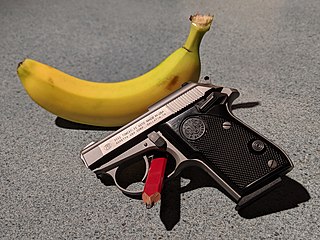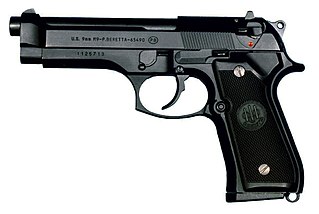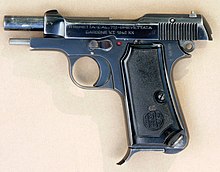
A machine pistol is an autoloading pistol capable of fully automatic fire, including stockless handgun-style submachine guns. The term is a calque of Maschinenpistole, the German word for submachine guns.

A semi-automatic pistol is a handgun that automatically ejects and loads cartridges in its chamber after every shot fired. Only one round of ammunition is fired each time the trigger is pulled, as the pistol's fire control group disconnects the trigger mechanism from the firing pin/striker until the trigger has been released and reset.

The Beretta 92 is a series of semi-automatic pistols designed and manufactured by Beretta of Italy. The Beretta 92 was designed in 1975, and production began in 1976. Many variants in several different calibers continue to be used to the present.

The .380 ACP (9×17mm) is a rimless, straight-walled pistol cartridge developed by firearms designer John Moses Browning. The cartridge headspaces on the mouth of the case. It was introduced in 1908 by Colt, for use in its new Colt Model 1908 pocket hammerless semi-automatic, and has been a popular self-defense cartridge ever since, seeing wide use in numerous handguns. Other names for .380 ACP include .380 Auto, 9×17mm, 9mm Browning, 9mm Corto, 9mm Kurz, 9mm Short, and 9mm Browning Court. It should not be confused with .38 ACP. The .380 ACP does not strictly conform to cartridge naming conventions, named after the diameter of the bullet, as the actual bullet diameter of the .380 ACP is .355 inches.

The Beretta Model 1934 is an Italian compact, semi-automatic pistol which was issued as the service pistol of the Royal Italian Army beginning in 1934. As the standard sidearm of the Italian army it was issued to officers, NCOs and machine gun crews. It is chambered for the 9mm Corto, more commonly known as the .380 ACP.

The Beretta Cheetah, also known by its original model name of "Series 81", or "80 Series", is a line of compact blowback operated semi-automatic pistols designed and manufactured by Beretta of Italy. They were introduced in 1976 and include models in .32 ACP, .380 ACP and .22 LR. Production paused in 2017, but Beretta revived the marque in 2023 with the release of the 80X.

The Beretta 21A Bobcat is a semi-automatic pocket pistol designed by Beretta in Italy. Production began in the late 1984, solely in the Beretta U.S.A. facility in Accokeek, Maryland. It is a further development of the Beretta Model 20, whose production ended in 1985.

The Beretta 950 is a semi-automatic pistol designed and manufactured by Beretta since 1952. It builds on a long line of small and compact pocket pistols manufactured by Beretta for self-defense. It was intended to be a very simple and reliable pocket pistol.

The Beretta 3032 Tomcat and Beretta 3032 Tomcat Inox are semi-automatic pocket pistols designed and manufactured by Beretta. They are chambered in .32 ACP and are small pistols, designed for concealed-carry and use as backup weapons. The Beretta 3032 Tomcat builds on a long line of small and compact pocket pistols for self defense manufactured by Beretta. The allure and popularity is commonly attributed to the loading procedure, which does not require the user to "rack" the slide to chamber a round, but rather place a round in the tip-up barrel before the magazine is inserted. This is especially popular for those with weaker or smaller hands.

The Beretta M1951 is a 9×19mm semi-automatic pistol developed during the late 1940s and early 1950s by Pietro Beretta S.p.A. of Italy. The pistol was produced strictly for military use and was introduced into service with the Italian Armed Forces and other Italian security forces as the Modello 1951 (M1951), replacing the Modello 1934 pistol chambered for the 9×17mm Short cartridge.

The Heckler & KochP7 is a German 9×19mm semi-automatic pistol designed by Helmut Weldle and produced from 1979 to 2008 by Heckler & Koch GmbH (H&K). The P7M13, a variant of the P7 with a double-stack magazine, was produced until 2000.

The Beretta M9, officially the Pistol, Semiautomatic, 9mm, M9, is the designation for the Beretta 92FS semi-automatic pistol used by the United States Armed Forces. The M9 was adopted by the United States military as their service pistol in 1985.

The Beretta Px4 Storm is a semi-automatic pistol intended for personal defense and law enforcement use. It is available in full size, Compact, and Subcompact versions. The Px4 uses a trigger and safety system similar to the Beretta 92 and the Beretta 8000 series, though it is distinguished from its predecessors by its light-weight polymer construction with steel inserts, standard Picatinny rail, and swappable grip backstraps. The full size and Compact versions use the same short-recoil, rotating barrel action as the Beretta 8000 series, whereas the Subcompact uses the tilt barrel system.

In American English, a pocket pistol is any small, pocket-sized semi-automatic pistol, and is suitable for concealed carry in a pocket or similar space.

The P-64 is a Polish semi-automatic pistol designed to fire the 9×18mm Makarov cartridge. The pistol was developed in the late 1950s at the Institute for Artillery Research by a team consisting of: W. Czepukajtis, R. Zimny, H. Adamczyk, M. Adamczyk, S. Kaczmarski and J. Pyzel. The P-64 is also known as the CZAK.
Llama Firearms, officially known as Llama-Gabilondo y Cia SA, was a Spanish arms company founded in 1904 under the name Gabilondo and Urresti. Its headquarters were in Eibar in the Basque Country, Spain, but they also had workshops during different times in Elgoibar and Vitoria. The company manufactured moderate-priced revolvers and self-chambering pistols in a wide variety of models. These were popular mainly in the European and Latin American export market, as well as domestically in Spain.

The Beretta Model 1923 pistol was a service pistol used by the Italian Army from 1923 until 1945. The M1923 was designed to consolidate the improvements of the 1915/19 model and to use the 9mm Glisenti round. However, due to the vast amount of handguns available after the end of World War I only 3000 samples, of about 10.000 produced, were purchased by the Italian Army.

The Beretta 70 is a magazine-fed, single-action semi-automatic pistol series designed and produced by Beretta of Italy, which replaced the earlier 7.65mm Beretta M1935 pistol. Some pistols in this series were also marketed as the Falcon, New Puma, New Sable, Jaguar, and Cougar. The gun is notable for its appearances in film, and is also the first compact Beretta pistol to feature several improvements commonly found in Beretta pistols for the rest of the century.

The Modelo 1905 is a pistol designed by Ferdinand Ritter von Mannlicher in 1899 and originally produced in Austria as the Mannlicher Model 1901. The Mannlicher Model 1901 was an improved version of the Model 1900, both of which were produced by Österreichische Waffenfabriks-Gesellschaft. All of these models have the same basic design and operation, but minimal adjustments were made to improve each of them. The Modelo 1905 is the version of the Model 1901 that the Argentine Army purchased from Steyr in 1905. This semi-automatic pistol has a unique and elegant appearance due to the curve of the handgrip. It is single action and uses a blowback operation system to reload. Like its predecessors, the Modelo 1905 has a non-detachable magazine that can be loaded from the top with a stripper clip.

The Beretta Model 1915 or Beretta M1915 is a semi-automatic pistol manufactured by Beretta, designed by Tullio Marengoni who was the chief engineer in the company, to replace the Glisenti Model 1910 which had a complex and weak firing mechanism. It is the first semi-automatic pistol, manufactured by the company, and issued as a service pistol in Royal Italian Army during World War I. The total production of the Beretta M1915 is estimated about 15,670 during 1915-1918, and about 56,000 of Beretta M1915/1917. Some of the pistols were also used in World War II until 1945. Its open slide design later became the characteristic for other Beretta pistols such as Beretta M1923, Beretta M1934, Beretta M1935, Beretta M1951, Beretta 70, Beretta 92, Beretta Cheetah, and Beretta M9.






















